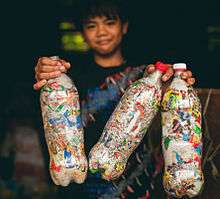Ecobricks

An ecobrick is a plastic bottle stuffed solid with non-biological waste to create a reusable building block. Ecobricks are used to make modular furniture, garden spaces and full scale buildings such as schools and houses. Ecobricks are a collaboration powered technology that provides a zero-cost solid waste solution for individuals, households, schools and communities. Also known as an Eco-Brick, a bottle brick, and Ecoladrillo, this local waste solution has come to be known as 'Ecobricks' (non-hyphenated) by a growing movement of communities around the world.[1]
Principles
Ecobricking is characterized by three general principles:
- Local Transformation: Using nearby and otherwise polluting and toxic non-biological material to make inert and useful Ecobricks.
- Cradle-to-cradle construction: Ensuring that at the end of building/furniture/garden's life that the ecobricks can be removed and reused (caution: cemented ecobricks are impossible to extricate without destroying them and releasing the packed plastic).
- Community Collaboration: The focused collaboration of a household, school or municipality to create ecobricks that will be used to construct something of use to the community.
History
Ecobricking plastic waste into bottles is a method for dealing with waste that has popped up organically around the world. Various simultaneous pioneers have helped shape the global movement and refine the technology. Susana Heisse an environmental activist around Lake Atitlan in Guatemala in 2004. Alvaro Molina began on the island of Ometepe in 2003. The technique builds upon the bottle building techniques developed by German architect Andreas Froese (using sand filled PET bottles) in South America in 2000.
In 2010, in the Northern Philippines, Russell Maier and Irene Bakisan[2] developed a curriculum guide of simplified and recommended practices to help local schools integrate ecobricks into their curriculum. Applying the ancestral ecological principles of the Igorots for building rice terraces, they integrated Cradle-to-cradle principles into Ecobrick methodology: ensuring that Ecobricks can reused at the end of the construction they are used in. Through the Department of Education the guide was distributed to 1700 schools in 2014.[3]
Construction

All that is needed to make an Ecobrick is a plastic bottle or container of some sort (including paper / laminate milk cartons) and a stick to stuff and compress a whole bunch of random everyday plastic materials inside of it. To start an Ecobrick, take a plastic bottle, rinse it out and leave it to dry. Use a stick to stuff it layer by layer with all of the plastics, non-biodegradables, and synthetics that would otherwise be thrown into a waste bin and eventually the Earth.[4]
Guidelines
- Pack bottles with non-biodegradables (like plastic, wrappers, styrofoam, etc.)
- No paper, no glass and no sharp metal
- Use a bamboo stick to pack bottles with as much non-biodegradables as possible.
- Use a colored cellophanes first to fill the very bottom and give brick a color.
- Use soft cellophanes to fill the bottle’s bottom corners and any air pockets.
- Keep to one brand of bottle. This will make building easier.
- Smaller bottles work too! Choose the ones that seem to be the most abundant in your community.
- Make sure each Ecobrick is completely free of wet / food / organic materials that should rather be composted to create new soil.
- Teachers and community leaders: Record submitted Ecobricks (color, volume, mass). This provides invaluable statistics afterwards.
Completed Ecobricks should be so densely stuffed that one can stand on top of them without deformation.
Context
.jpg)
Plastics are made from petro-chemicals. These chemicals don’t fit back into the ecologies around us. Scientific studies show that these chemicals are toxic to humans— we know this when we smell plastics burning. Eventually, plastics that are littered, burned or dumped degrade into these poisonous chemicals. Over time, these chemicals leach into the land, air and water,[5] and are absorbed by plants and animals. Eventually they reach us, causing birth defects, hormonal imbalances, and cancer. Even engineered dump sites are not a solution. Whether it is ten years, or one hundred, these chemicals will eventually seep into the biosphere,affecting our farms & families.
A tremendous amount of plastic waste litters our planet every year and its cost is huge. According to the UNEP 2014 Yearbook, plastic contamination threatens marine life, tourism, fisheries and businesses and the overall natural capital cost for plastic waste is $75 billion each year.[6] Since plastics don’t biodegrade but photodegrade, plastics in the fields or water just break down into small pieces. These toxic pieces are then absorbed by plants and animals and come back to us, which leads to fatal consequences like cancer and birth defects.[7]
Plastics need to be either eliminated, or put in the right place. PET bottles will last for 300–500 years if they are kept from sunlight. When packed tightly with other non-biodegradeables, they make an amazing brick that can be used over and over for building. They also become time capsules— a gift to future generations.

Case studies
- In the village of Besao in the Northern Philippines, hospital custodian Jane Timbung set about packing one ecobrick a day to revamp her ailing home that her neighbors had been ridiculing. Two years later her home is tourist attraction that has been featured in both local and national media.
- On the isolated volcano island of Ometepe in Lake Nicaragua, Alvaro Molina, distraught by the plastic waste that had nowhere to go in his community, began ecobricking at his hotel. His community is now one of the cleanest in the country, with dozens of local schools building with ecobricks and a micro economy formed around ecobrick buying and selling.
- In Santa Fe, New Mexico, USA, Jo Stodgel is encouraging his community to stuff ecobricks with creative workshops for youth, river cleanup projects, and design / build projects. He is also innovating solutions to make the practice much more accessible and easy, such as using milk cartons instead of bottles.
References
- ↑ Rob, Hopkins. "EcoBricks and education: how plastic bottle rubbish is helping build schools". www.theguardian.com. The Guardian. Retrieved 2014-05-29.
- ↑ Shruti Verma (June 5, 2014). "World Environment Day Special: Ecobricks". Nestopia. Retrieved February 14, 2016.
- ↑ Dison, Gina (July 11, 2014). "Dep Ed USec graces eco- brick launching in Apayao". Northern Philippine Times.
- ↑ Stodgel, Jo. "ECOBRICK.IT". www.ecobrick.it. Upcycle Santa Fe. Retrieved 4 February 2015.
- ↑ Barnes, David K. A.; Galgani, Francois; Thompson, Richard C.; Barlaz, Morton (July 27, 2009). "Accumulation and fragmentation of plastic debris in global environments". The Royal Society, Biological Sciences. 364: 1985–98. doi:10.1098/rstb.2008.0205. PMC 2873009
 . PMID 19528051.
. PMID 19528051. - ↑ UN Environment Programme. "Plastic waste causes $13 billion in annual damage to marine ecosystems, says UN agency". http://www.un.org. United Nations News Service. Retrieved 23 June 2014. External link in
|website=(help) - ↑ Neeti, Rustagi; Pradhan, S. K.; Singh, Ritesh (Sep 2011). "Public health impact of plastics: An overview". Indian Journal of Occupational and Environmental Medicine. 15 (3): 100–3. doi:10.4103/0019-5278.93198. PMC 3299092
 . PMID 22412286.
. PMID 22412286.
External links
-
 EcoARK (French)
EcoARK (French) - The open source Vision Ecobrick Start Guide and Construction Guide are an opensource, translated and free resource available at www.Ecobricks.org. An international team develops and disseminates the Vision Ecobrick Guide globally.